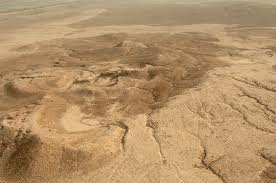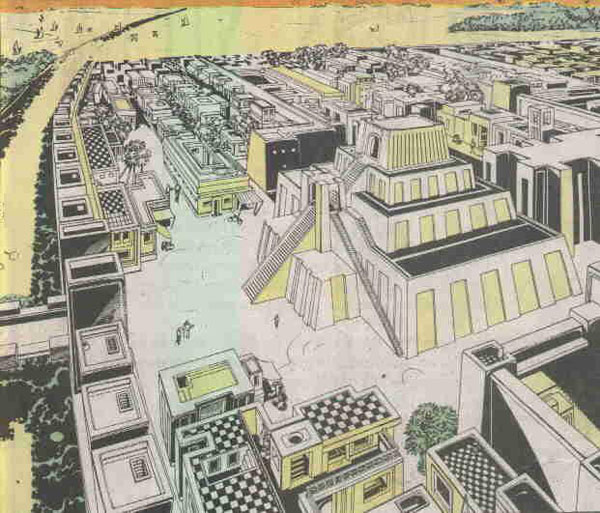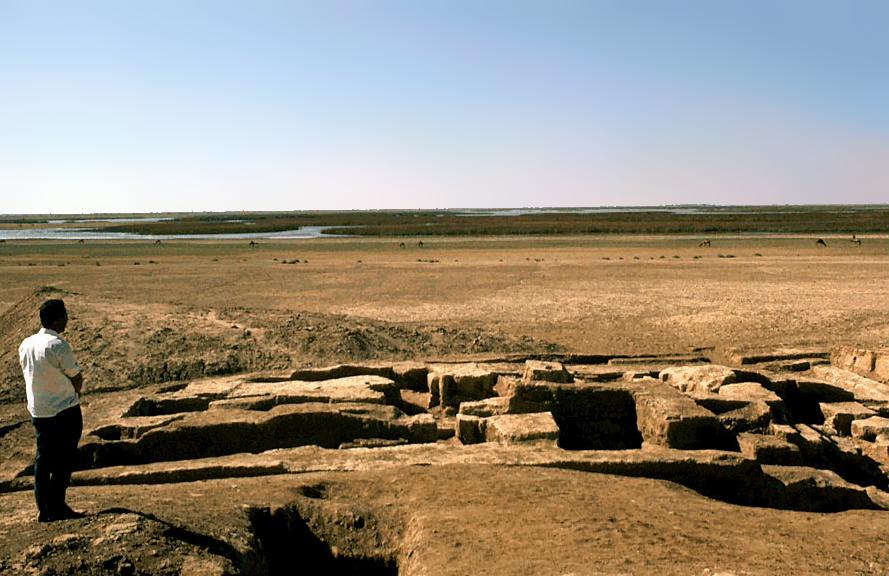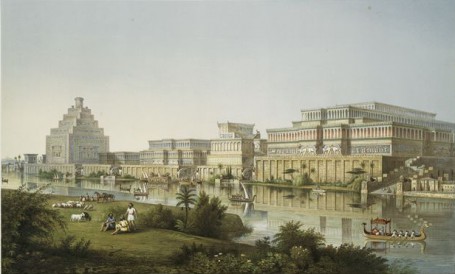



Text source: Wikipedia
LAGASH
Lagash[4]/ثˆleةھة،أ¦تƒ/ is an ancient city located northwest of the junction of the Euphrates and Tigris rivers and east of Uruk, about 22 kilometres (14 mi) east of the modern town of Ash Shatrah. Lagash was one of the oldest cities of the Ancient Near East. The ancient site of Surghul/Nina is around 6 miles (9.7 km) away. NearbyGirsu, about 25 km (16 mi) northwest of Al-Hiba, was the religious center of the Lagash state. Lagash's temple was E-Ninnu, dedicated to the god Ningirsu.
History
From inscriptions found at Girsu such as the Gudea cylinders, it appears that Lagash was an important Sumerian city in the late 3rd millennium BC. It was at that time ruled by independent kings, Ur-Nanshe (24th century BC) and his successors, who were engaged in contests with the Elamites on the east and the kings of "Kienؤir" and Kish on the north. Some of the earlier works from before the Akkadian conquest are also extremely interesting, in particular Eannatum's Stele of the Vultures and Entemena's great silver vase ornamented with Ningirsu's sacred animal Anzu: a lion-headed eagle with wings outspread, grasping a lion in each talon. With the Akkadian conquest Lagash lost its independence, its ruler or ensi becoming a vassal of Sargon of Akkad and his successors; but Lagash continued to be a city of much importance and above all, a centre of artistic development.
After the collapse of Sargon's state, Lagash again thrived under its independent kings (ensis), Ur-Bau and Gudea, and had extensive commercial communications with distant realms. According to his own records, Gudea brought cedars from the Amanus and Lebanon mountains in Syria, diorite from eastern Arabia, copper and gold from central and southern Arabia, while his armies were engaged in battles with Elam on the east. His was especially the era of artistic development. We even have a fairly good idea of what Gudea looked like, since he placed in temples throughout his city numerous statues or idols depicting himself with lifelike realism, (Statues of Gudea). At the time of Gudea, the capital of Lagash was actually in Girsu. The kingdom covered an area of approximately 1,600 square kilometres (620 sq mi). It contained 17 larger cities, eight district capitals, and numerous villages (about 40 known by name). According to one estimate, Lagash was the largest city in the world from ca. 2075 to 2030 BC.[5]
Soon after the time of Gudea, Lagash was absorbed into the Ur III state as one of its prime provinces.[6] There is some information about the area during the Old Babylonian period. After that it seems to have lost its importance; at least we know nothing more about it until the construction of the Seleucid fortress mentioned, when it seems to have become part of the Greek kingdom of Characene.
Conflict with Umma
In c.2450 BC, Lagash and the neighbouring city of Umma fell out with each other after a border dispute. As described in Stele of the Vultures the current king of Lagash, Eannatum, inspired by the patron god of his city, Ningirsu, set out with his army to defeat the nearby city.[7] Initial details of the battle are unclear, but the Stele is able to portray a few vague details about the event. According the Stele's engravings, when the two sides met each other in the field, Eannatum dismounted from his chariot and proceeded to lead his men on foot.[8] After lowing their spears, the Lagash army advanced upon the army from Umma in a dense Phalanx.[9] After a brief clash, Eannatum and his army had gained victory over the army of Umma. Despite having been struck in the eye by an arrow, the king of Lagash lived on to enjoy his army's victory.[10] This battle is one of the earliest organised battles known the scholars and historians.[11]
Dynasties of Lagash
These dynasties are not found on the Sumerian King List, although one extremely fragmentary supplement has been found in Sumerian, known as the rulers of Lagash.[12] It recounts how after the flood mankind was having difficulty growing food for itself, being dependent solely on rainwater; it further relates that techniques of irrigation and cultivation of barley were then imparted by the gods. At the end of the list is the statement "Written in the school", suggesting this was a scribal school production. A few of the names from the Lagash rulers listed below may be made out, including Ur-Nanshe, "Ane-tum", En-entar-zid, Ur-Ningirsu, Ur-Bau, and Gudea.
First Dynasty of Lagash
Ruler Proposed reign Notes
Enhengal
Lugal-sha-engur (Lugal-Suggur) high priest or ensi
Ur-Nanshe (Ur-nina) ca. 2500 BC king
Akurgal
Eannatum ca. 25th century BC grandson of Ur-Nanshe, king, took Sumer away from Enshagkushana of Uruk and repulsed the armies of Kish, Elam and Mari
En-anna-tum I ca. 25th century BC brother to Eanatum, high priest, Ur-Luma and Illi of Umma, as well as Kug-Bau of Kish gained independence from him.
Entemena ca. 25th century BC son of Enanatum I, king, contemporary with Lugal-ure (or Lugalkinishedudu) of Uruk and defeated Illi of Umma
Enanatum II
Enentarzid
Lugalanda
Urukagina ca. 2300 BC king, defeated by Lugalzagesi of Uruk, issued a proclamation of social reformes.
Second Dynasty of Lagash
Ruler Proposed reign (short chronology) Proposed reign (middle chronology) Notes
Lugalushumgal
Puzer-Mama
Ur-Utu
Ur-Mama
Lu-Baba
Lugula
Kaku or Kakug
Ur-Bau or Ur-baba 2093 BC – 2080 BC 2157 BC – 2144 BC
Gudea 2080 BC – 2060 BC 2144 BC – 2124 BC Son-in-law of Ur-baba
Ur-Ningirsu 2060 BC – 2055 BC 2124 BC – 2119 BC Son of Gudea
Pirigme or Ugme 2055 BC – 2053 BC 2119 BC – 2117 BC Grandson of Gudea
Ur-gar 2053 BC – 2049 BC 2117 BC – 2113 BC
Nammahani 2049 BC – 2046 BC 2113 BC – 2110 BC Grandson of Kaku, defeated by Ur-Namma
Archaeology
Lagash is one of the largest archaeological mounds in the region, measuring roughly 2 by 1 miles (3.2 by 1.6 km). Estimates of its area range from 400 to 600 hectares (990 to 1,500 acres).
The site is divided by the bed of a canal/river, which runs diagonally through the mound. The site was first excavated, for six weeks, by Robert Koldewey in 1887.[13] It was inspected during a survey of the area by Thorkild Jacobsen and Fuad Safar in 1953, finding the first evidence of its identification as Lagash. The major polity in the region of al-Hiba and Tello had formerly been identified as إ IR.BUR.LA (Shirpurla).[14]
Tell Al-Hiba was again explored in five seasons of excavation between 1968 and 1976 by a team from the Metropolitan Museum of Art and the Institute of Fine Arts of New York University. The team was led by Vaughn E. Crawford, and included Donald P. Hansen and Robert D. Biggs. The primary focus was the excavation of the temple Ibgal of Inanna and the temple Bagara of Ningirsu, as well as an associated administrative area.[15][16][17][18] The team returned 12 years later in 1990 for a final season of excavation led by D. P. Hansen. The work primarily involved areas adjacent to an as yet unexcavated temple. The results of this season have apparently not yet been published.[19]
Text source: Wikipedia
ط§طµظ„ ط§ظ„ظ†طµ ظ…ظ† ظ…ظˆظ‚ط¹ ط§ظ„ظˆظƒظٹط¨ظٹط¯ظٹط§
ظ„ط¬ط´
ط§ظ„ط±ط§ط¨ط· ظپظٹ ظ…ظˆظ‚ط¹ ط§ظ„ظˆظٹظƒظٹط¨ظٹط¯ظٹط§
You are welocome to send your comments and proposals as well any useful photos, documents, links for website update using our following address:
ط§ظ„طµظپطط© طھط±طط¨ ط¨ط§ظٹط© ظ…ظ„ط§طط¸ط§طھ ط§ظˆ ظ…ظ‚طھط±طط§طھ ظƒظ…ط§ طھطھط·ظ„ط¹ ظ„ط§ط³طھظ„ط§ظ… ط§ظٹط© طµظˆط± ط§ظˆ ظˆط«ط§ط¦ظ‚ ط§ظˆ ط±ظˆط§ط¨ط· ظ…ظپظٹط¯ط© ظ„طھطط¯ظٹط«ظ‡ط§ ط¹ط¨ط± ط§ظ„ظ…ط±ط§ط³ظ„ط© ط¹ظ„ظ‰ ط§ظ„ط¹ظ†ظˆط§ظ† ط§ظ„ط§ظ„ظƒطھط±ظˆظ†ظٹ ط§ظ„طھط§ظ„ظٹ
info@uruk-warka.dk
Other updates ... طھطط¯ظٹط«ط§طھ ط§ط®ط±ظ‰
CITY-STATES OF ANCIENT - SUMER ... ط¯ظˆظ„ ط§ظ„ظ…ط¯ظ† ظپظٹ ط³ظˆظ…ط±
The British Museum - ط§ظ„ظ…طھطظپ ط§ظ„ط¨ط±ظٹط·ط§ظ†ظٹ